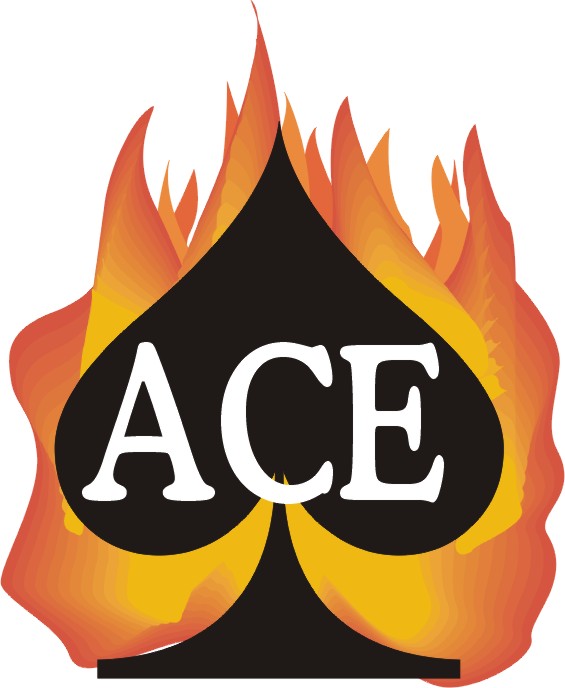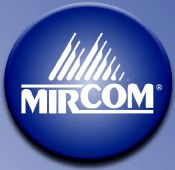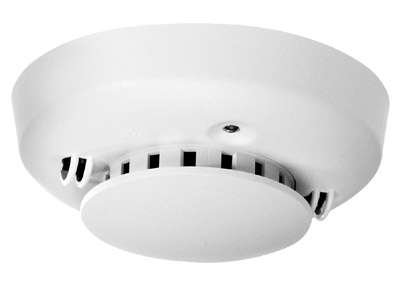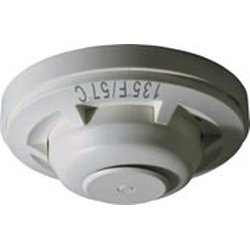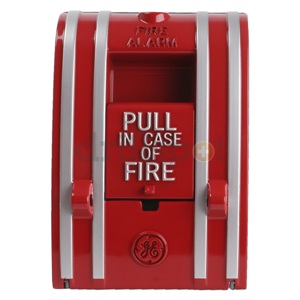| Building
Life Safety, Security & CCTV Systems |
||||||||||||||
| Extinguishment,
Deluge, & Sprinkler Systems |
||||||||||||||
| Fire
Safety and Emergency Planning |
||||||||||||||
FIRE ALARM SYSTEMS
Building fire alarm systems usually consist of a common control (mounted in a metal box), manual pull stations at every exit door, smoke detectors in the hallways, and some means of audibly and/or visually notifying the occupants of the buildling that an alarm has occurred. The audible signals can consist of bells or buzzers, but in some systems, an alarm tone is generated through a series of speakers located on each floor of the premise. Where hearing impaired patients or occupants are located, it is usual to have strobe lights located along corridors and in individual rooms that indicate a fire exists in the building. Most fire alarm systems employ "zoned" annunciators so that fire fighting personnel can be dispatched to the proper area of the building. The common control employs several features to enable the occupants to identify problems within the system. Correction of any troubles should be left in the hands of the trained technicians at Ace Fire Prevention Ltd. There are several different manufactures of building fire and evacuation type systems. Here are a few of the more common ones. We've provided links to some of the manufacturers so you can investigate their equipment and services, or (alternatively) you can contact us for a competitive quotation.
RESPONSIBILITIES / SERVICESDaily Testing - is the responsibility of the building management or an individual they've designated to perform these duties. They include:
Monthly Testing - Requires the building management or designated individual to actually initiate a fire alarm by activating one of the building's pull stations. You can download the monthly test record in Adobe PDF, Word or WordPerfect formats. It's usually a good idea to post the date and time of the test so that tenants/occupants are aware of the situation and won't be unduly alarmed. It might be a good idea to suggest that they practice their individual escape plans during the test. The montly test is to ensure that all audible and visual alarm indicators function properly and are loud (or visible) enough to alert all the occupants to a fire condition. In addition to this test, the designated individual should also ensure that he responds to issues and concerns expressed to him by the tenants/occupants with regard to the operation of the fire alarm system. Annual Testing - The Annual Test of the fire alarm system is performed by qualified technical personnel to a specific standard called ULC CAN4-S536 (Standard for the Testing of Fire Alarm Systems). Ace Fire Prevention is one of a number of companies in the Lower Mainland that perform this service. In some municipalities (Vancouver, Coquitlam, Richmond, North Vancouver, Abbotsford, Surrey, North Vancouver District, Squamish, Whistler, Chilliwack, Pitt Meadows, and Courtney), the individuals performing the test must be certified by A.S.T.T.B.C. The test report must be submitted to the building owner's representative in a format approved by the local authority. The Verification - Verification of a fire alarm system must take place when the system is first commissioned and is one of the final steps to obtaining an occupancy permit for the building. The test is performed to ULC CAN-S537-04 (Standard for the Verification of Fire Alarm Systems) by the fire alarm system manufacturer, or an individual authorized by the manufacturer to perform the service. In some instances, the Electrical Design Engineer is involved in the process as well. This is the most rigorous of testing procedures the system will have to undergo in it's lifetime. Not only are individual devices tested for a variety of conditions (not just operation), each device in the system must be examined for proper PLACEMENT. This ensures the pull station/smoke detector/heat detector/bell is installed in accordance with the manufacturer's instructions, the applicable building codes/bylaws, and ULC CAN-S524 (The Standard for Installation of Fire Alarm Systems). In Vancouver the service agency (or individual) must be on the approved list in order to perform verificaitons in the city. Most Lower Mainland municipalities follow this list. In addition, a verification may be required if a device is replaced or added to the system. Please check with your local civic authority (Electrical Inspections or Planning) and follow their guidelines to ensure your system remains in compliance. For more information (or a competitive quotation) on any of the above services, please contact us at (604) 275-0075 or send us an email.
SMOKE DETECTORSSmoke and fire detectors should be considered an integral part of any home or business security system. In most all instances involving fire, a smoke detector provides sufficient warning to the residents/occupants to enable them to evacuate the premises safely, notify the fire department, and minimize the damage to the structure and contents. A security or fire alarm system that employs integrated smoke detectors is by far the best way to protect the building's occupants. In this instance the detectors are powered by a stand-by battery that will ensure continued protection even in the complete absence of electrical power or a "brown-out". Smoke alarms that are battery operated should have the batteries replaced every six months. It's a good idea to mark the replacement date on a piece of masking tape and stick it onto the body of the detector. Use only alkaline or lithium type batteries and make sure you double check the expiry date on the battery and test it before you place it in the unit. Most smoke detectors installed today are wired directly to the household electrical system. These units are vulnerable to electrical failures (they won't function in the absence of power). Most house fires start in the electrical wiring so it's a good idea to have a battery operated smoke alarm installed as a "back-up". There are two types of smoke detectors (alarms): Ionization type smoke detectors - utilize a small source of radioactive material (usually Americium) that in fact ionizes airborne particulates and attracts them to to one side or the other of a polarized grid. When sufficient particles accumulate, the unit goes into an alarm condition. This type of detector works best for fast flaming fires that produce small amounts of smoke. It's also prone to false alarms when installed close to bathrooms or kitchens with older style dishwashers. Steam from your hot bath, shower, or operating dishwasher may accidentally "set-off" one of these units). It SHOULD NOT be used in a residential application as most house fires tend to generate dense smoke.
Photoelectric type smoke detectors - utilize an infrared light source (called the emitter), and a light sensitive element (called the receiver), both of which are located inside the sensing chamber. Smoke particles obscure the light from the transmitter and the unit goes into alarm. This type of detector is best used in residential applications, as it provides extremely good early warning to smoldering type fires that tend give off dense smoke and noxious fumes.
GE/EST C2M-PD Series Smoke Detector
HEAT DETECTORSThese types of detectors use two primary methods of sensing a fire. The first involves a thermostat which is preset at the manufacturer to sense a temperature increase on the order of fifteen (15) degrees per minute. When this "thresh-hold" is crossed the detector will trigger an alarm condition. This type of sensor is called a "rate-of-rise" detector. The second involves a fusible "disk" located in the centre of the detector. Heat of sufficient temperature will melt the disk and thereby activate the sensor. Most detectors sold today are "combination units" in that they incorporate both detection methods. Areas of high temperature and rapidly changing conditions (like most boiler rooms) require fixed temperature detectors (sensors employing a "rate of rise" element will false alarm in these areas). Fixed temperature detectors must be tested "to destruction" every three (3) years.
System Sensor 5601 Heat Detector
PULL (MANUAL) STATIONSThese devices are used to manually initiate an alarm and are normally located on what's termed "access to egress" routes (which is "fancy language" for being installed next to an exit door). They're normally RED in colour and incorporate instructions for activation on their faces.
GE 270-SPO Manual Pull Station
BEAM DETECTORSUse the same type of detection components found in the common photo-electric smoke detector, the main difference being in that the "sensing chamber" is actually the entire protected area. The emitter (usually infra-red) is located on one wall or a corner of the room, while the receiver is located on the opposite wall or corner. Smoke particulates or heat "waves" from a fire obscure or distort the infra-red energy directed at the receiver and the unit goes into alarm. If the receiver is completely blocked (by a vehicle or lift truck cargo for instance) the detector will go into "trouble" (which is reported to the common control) until the vehicle or item is removed.
IMPORTANT: Never paint any sensor or other fire alarm device!
GENERATORSMany buildings utilize an emergency generator to power key lights and an elevator in the event of the failure of the main electrical grid or "brown out". Generators are usually diesel powered, however a number of them derive their fuel source from a connection to the local natural gas supply. Regardless of how your generator is powered, regular monthly testing should be performed to ensure peak response to an emergency. You should also check to ensure the block heater is functional and that the starter batteries are maintaining a full charge. In the case of the former, most generators are designed to start "under load" and at their maximum rated RPM. A non-functional block heater could impact the life expectancy of critical engine components due to thermal stresses associated with such a rapid start. Ace Fire Prevention Ltd. can provide you with a comprehensive survey of your generator and sub systems as well as assist you with setting up a proper test program. For more information, please contact us!
FIRE ALARM SYSTEM FAQMy building has an old 12 volt fire alarm panel installed. Can I upgrade the heat detectors in the hallways and stairwells to system smoke detectors? Unfortunately that's not as simple as it sounds. Modern two wire type smoke detectors draw power from the main alarm panel. Your system is designed to operate "contact type" devices only. "Contact" devices include heat detectors (which incorporate a thermal element and simple "normally open" switch) and manual pull stations. Furthermore, your particular system does not supervise any of the field devices. In other words, you can disconnect them without affecting the "status" of the panel (it won't go into "trouble" as most modern fire alarm systems would). It is possible to upgrade your fire alarm panel so that you can incorporate system smoke detectors without having to install new wiring, however. Many municipalities recognize the need for enhanced life safety and it is not unusual for a variance to be granted that will allow for special installations like this. For more information, you can contact us!
How often should the batteries in our fire alarm panel require service? They are tested annually to ensure they are capable of meeting the code requirements for your building type and occupancy. In normal stand-by type conditions, most sealed lead acid batteries will require replacement every four to five years. Some manufacturers actually stipulate they must be replaced every four years.
How often should system smoke detectors be replaced? There is currently no clearly defined replacement policy other than when the detector fails an annual test or it becomes damaged by water or other external event (usually associated with someone moving furniture or other large objects down the hallway). The important thing to remember is that system smoke detectors and heat detectors (that employ a relay base) are ULC® Cross-Listed to specific control panels (some are even "smart devices" that communicate their status to the fire alarm panel). This means that any detector that is replaced must be compatible with your system. How would you know that it is? The answer's simple: contact us! Most common heat detectors and manual pull stations (also known as contact type devices) are only required to be ULC listed for use with a fire alarm system.
fire
extinguishers / emergency lighting
/ sprinklers / fire
alarm / cctv Copyright
© 2005 - 2014 by Ace Fire Prevention Ltd.
|
||||||||||||||
